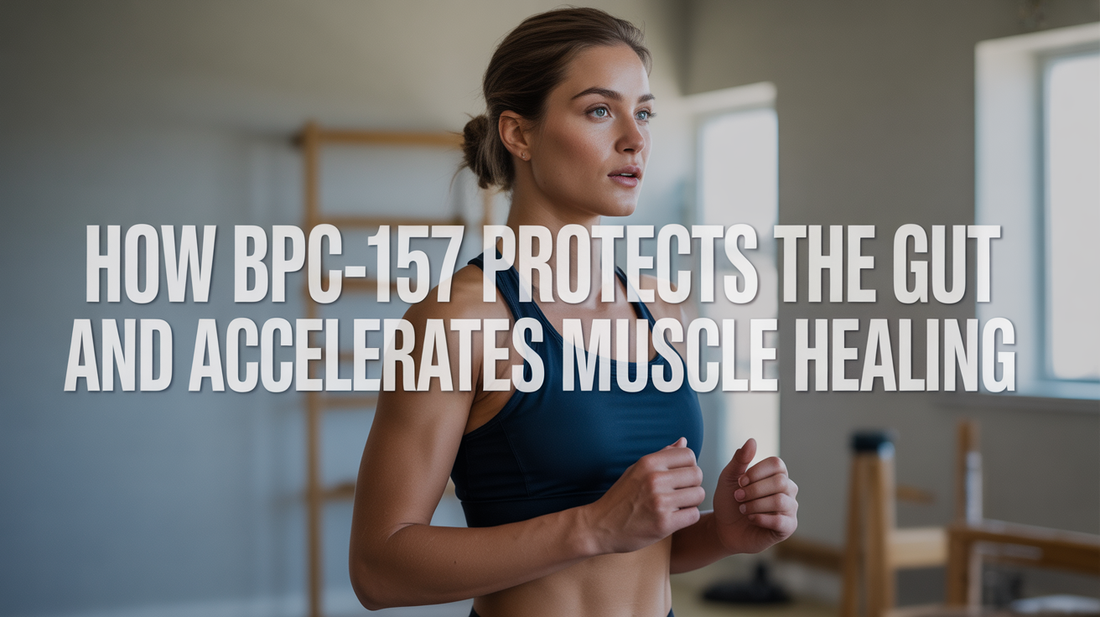
BPC-157 Protects the Gut and Accelerates Muscle Healing - Mechanisms Explained
Share
As part of peptide therapy for muscle recovery, BPC-157 shields the digestive lining and activates repair signals that support intestinal health and accelerate muscle healing.
In this Article:
- The key ways BPC-157 fortifies your gut barrier, drives new blood vessel growth, controls inflammation and oxidative stress, promotes muscle and connective tissue repair, and the latest preclinical findings.
- Practical takeaways for applying BPC-157 mechanisms in your muscle recovery plan, including dosing insights and integration strategies.
How BPC-157 Strengthens the Gut Barrier
BPC-157 bolsters the connections between epithelial cells by reinforcing tight junction proteins, reducing intestinal permeability and preventing harmful substances from crossing into the bloodstream.
Mucosal Barrier Support
It elevates levels of occludin and claudin, fortifying cell-to-cell adhesion and preserving the structural integrity of the intestinal lining against mechanical and chemical stress.
Ulcer Prevention and Repair
It stimulates mucus production, enhances blood flow to gastric tissues, and balances acid secretion, promoting faster healing of existing lesions while protecting the lining from new ulcer formation.
Learn: Peptide Therapy for Muscle Recovery
How BPC-157 Drives Vascular Regeneration
New blood vessel formation provides essential nutrients, oxygen, and growth factors to injured tissues, ensuring rapid delivery of repair signals and metabolic support for healing.

Stimulation of VEGF and FGF
BPC-157 upregulates vascular endothelial growth factor (VEGF) and fibroblast growth factor (FGF), promoting capillary sprouting and network expansion.
- Endothelial Proliferation: Encourages growth of new endothelial cells [1].
- Tube Formation: Facilitates the creation of new blood vessel structures.
Nitric Oxide Modulation
BPC-157 influences endothelial nitric oxide synthase (eNOS) activity, increasing nitric oxide (NO) production to dilate vessels and improve microcirculation in injured areas.
- Vascular Dilation: Reduces resistance for smoother blood flow [2].
- Ischemia Reduction: Mitigates low-oxygen stress to support ongoing repair.
Learn: TB-500 in Focus: Accelerating Cell Migration for Faster Recovery
How BPC-157 Controls Inflammation and Oxidative Stress
BPC-157 regulates key signaling pathways to contain inflammation and shields cells from oxidative damage, creating an optimal environment for repair.
Prostaglandin Balance
It modulates COX-2 expression, lowering pro-inflammatory prostaglandin E₂ (PGE₂) in affected tissues.
This rebalances cyclooxygenase activity, helping to reduce swelling and discomfort.
Cytokine Modulation
BPC-157 downregulates pro-inflammatory cytokines like TNF-α and IL-6, curbing excessive immune activation.
A balanced cytokine response prevents unnecessary collateral tissue damage during the healing phase.
Antioxidant Defense Enhancement
It boosts production of endogenous enzymes such as superoxide dismutase and catalase.
These antioxidants neutralize reactive oxygen species and protect cellular components from lipid peroxidation.
Learn: Nutrition Strategies to Amplify Peptide-Driven Repair
How BPC-157 Promotes Muscle and Connective Tissue Repair
By guiding repair cells, enhancing extracellular matrix remodeling, and optimizing collagen alignment, BPC-157 helps restore structural integrity, strength, and flexibility to damaged muscle and connective tissues over time [3].
Cell Recruitment and Migration
This peptide drives chemotactic signals that recruit fibroblasts, myoblasts, and vascular cells to injury sites, accelerating tissue regeneration and fostering an environment conducive to comprehensive healing.
Collagen Synthesis and Remodeling
BPC-157 promotes balanced synthesis of Type I and Type III collagen while supporting enzymatic remodeling processes, resulting in stronger, more elastic tissue with reduced scarring and improved functional resilience.
Key Preclinical Evidence
Extensive animal studies establish the foundation for BPC-157’s therapeutic promise and guide the design of future clinical trials.
Gastric Ulcer Models
In rodent ulcer experiments, BPC-157 accelerated lesion closure and restored mucosal thickness more rapidly than untreated groups.
Researchers observed elevated levels of growth factors and increased epithelial cell proliferation, confirming enhanced tissue regeneration and strengthened barrier function.
Tendon and Ligament Experiments
In tendon injury models, animals treated with BPC-157 exhibited greater tensile strength and faster recovery of load-bearing capacity.
Histopathological analysis revealed improved collagen fiber alignment, decreased scar tissue formation, and more organized extracellular matrix remodeling, indicating a comprehensive repair response.
Learn: Designing Your Peptide Cycle: Dosage, Duration & Breaks
Frequently Asked Questions
Find concise explanations to frequent queries about BPC-157’s gut protection, vascular regeneration, inflammation control, and tissue healing mechanisms.
What makes BPC-157 unique compared to other peptides?
BPC-157 combines gut-protective and tissue-regenerative properties in a single molecule, offering dual support for gastrointestinal integrity and musculoskeletal healing.
How should I interpret preclinical results for human use?
Animal data highlight potential benefits but may not fully reflect human outcomes; clinical trials are needed to confirm dosing, safety, and efficacy in people.
Are there any safety concerns with BPC-157?
No major adverse events have been reported in animal studies, but human safety profiles remain under investigation; choose suppliers with verified purity and follow recommended guidelines.
Can BPC-157 and TB-500 be used together?
Combining BPC-157 with TB-500 can create complementary effects—gut barrier support and enhanced cell migration—but professional guidance is recommended for stacking protocols.
